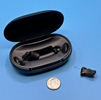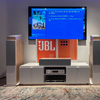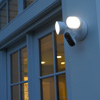We may earn commissions when you buy from links on our site. Why you can trust us.
Samsung S95D Review: The Best OLED Big Screen Yet?
When you choose a top-of-the-line TV, you expect its picture to not only provide hours of enjoyment for you and your family but also suitably impress all your friends. On that score, Samsung's 77-inch OLED S95D (Q77S95DA) certainly delivers, impressing even those in my jaded household, which has seen scores of big screens come and go over the years.
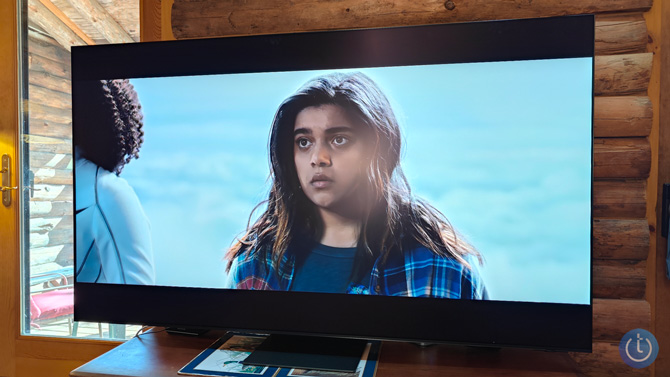
The Samsung OLED S95D starts with a crisp 4K OLED (organic light emitting diode) panel, which delivers a picture that is generally more intense and sharper than LCD TVs. Samsung has added a quantum dot layer to give colors an extra boost, and then – new for this generation of quantum dot OLEDs – it has added anti-glare glass to reduce annoying reflections. As seen in the image above, the glare from a bright light reflected off the screen is heavily muted compared to a standard glossy OLED panel.
Typically, OLED displays eschew anti-glare glass because it can diminish the overall brightness of the picture. However, Samsung has figured out a way to make it work, delivering one of the most impressive OLED pictures I've seen while virtually eliminating all distracting reflections. The only downside? It comes with an equally impressive price tag: $4,599.
| + Pros | – Cons | ||
|
|
||
|
|||
Setup and design
To match its beautiful picture, Samsung has created an equally attractive design. Rather than relying on a pair of spindly legs, the QN77S95DA rests on a heavy Z-shaped center pedestal that makes the set appear to hover above a tabletop. It's an elegant design, if a little tricky to install and set up.
Most big-screen TVs come with instructions that admonish you not to maneuver them around your living room on your own. But usually, you can get away with setting them up single-handedly. Not so with the Samsung OLED S95D.
First, even though the Samsung OLED is skinny at just 0.4 inches deep, it is still a very substantial set. The 77-inch picture (measured diagonally) means the display is 68 inches wide. In addition, it weighs a challenging 88.2 pounds with the stand. Indeed, when the 26-pound stand is attached to what is essentially one gigantic piece of glass, it becomes unwieldy for a single person to position the TV. Even with two people moving the Samsung S95D, if you're not careful, the base can flex the glass of the set, threatening to damage the screen.
Once you've got it upright, making all the necessary source connections is a snap. That's because the Samsung OLED S95D conceals all the connecting cables by using an external box, where you can plug up to 4 HDMI sources (including one eARC device, such as a soundbar) and 3 USB devices. There's also an Ethernet port, optical audio output, and a coaxial connection for an antenna. The box then connects to the back of the TV using a single cable (Samsung calls it One Connect). Then, you can hide the box itself by hanging it on the back of the center-mounted pedestal or placing it off to the side. (The One Connect cable is flat, so it can also accommodate a flush wall mount.)
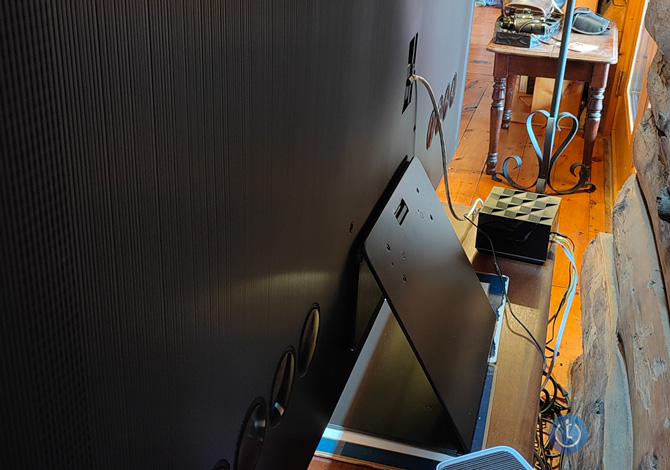
Picture performance
To put the Samsung OLED S95D into its best picture mode, I recommend using its preset Movie Mode, which I used for the majority of the testing period. For serious movie nights, the TV's Filmmaker Mode can be even better under the right circumstances. It is designed to turn off digital video enhancements to display the picture as the director intended. However, it can be too dark for everyday viewing.
Also noteworthy is the fact that Samsung's OLED S95D boasts the Pantone logo. This means that the TV has been tested and validated for adhering to the color standards set by Pantone, which art directors and designers have used for decades. So, in Movie and Filmmaker modes, skin tones, the deep greens of tropical scenes, and vibrant reds of precious stones look realistic and lifelike.
All this was evident during our testing, whether it was the fiery red of Ferrari in Formula 1: Drive to Survive or the azure waves of Avatar: The Way of Water. And no matter how fast the action was, the Samsung OLED S95D's 120-Hz native panel had no trouble keeping up without blurring objects or stuttering elements.
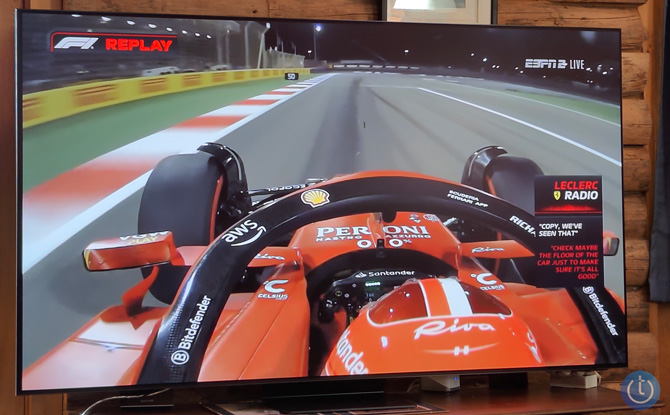
The 77-inch screen size means this set is really about movies – big, sprawling, blockbuster movies. In Movie Mode, raging storms with massive waves whipped across the screen with impressive detail so that you could see every drop of salty spray. Lightsaber fights on the flight deck of a Republic ship had a clarity that was unsurpassed by other TVs and was truly cinematic. And in the serpent's tunnel in Star Wars: The Rise of Skywalker, there was no posterization or banding of shadows. Yet, all the ribs of the cave walls were visible.
Switching the Samsung OLED S95D into 4K Filmmaker Mode, I couldn't resist returning to Alfonso Cuarón's movie Gravity. With the sprawling space shuttle, there were no stray edges or artifacts. The colors were solid and true, the earth's penumbra was a wondrous blue, and there were no artificial halos around the astronauts moving against the inky black of space. Indeed, perfectly deep blacks are one of the unmatched strengths of OLED sets, and the Samsung OLED S95D has demonstrated this again and again.
Samsung does tout a setting it calls Intelligent Mode, and some owners may find it preferable. It uses sensors to automatically adjust the picture depending on the light levels in your room and the type of programming you are watching. In general, Intelligent Mode tends to boost highlights like the white of a spacesuit and increases the contrast in pictures. It can also look cooler, which means whites tend toward the blue end of the spectrum rather than yellow. Intelligent mode also revealed more stars in the Milky Way and brought out a spinning flashlight with more sharpness. But, in the process, it sacrificed details in other highlights.
Some of this is a matter of taste and how faithful you want to be in reproducing what the original movie or video was intended to look like. For example, using Movie Mode to watch Cocaine Bear (not destined to become a movie classic, I'll grant you), the expansive green vista of the Tennessee Valley, and the Great Smokey Mountains looked stunning. But then, it was too dark to make out all the details in the Ray Liotta and the bear scene on the cliff. Switching to Intelligent Mode revealed all the details and facial expressions (of Liotta, not the bear) in a low, blue light.
One feature premium sets like the Samsung 77-inch OLED S95D excel at versus less expensive models is the ability to display lower-resolution pictures, a skill known as upscaling. Here again, the Samsung OLED S95D did not disappoint. A considerable amount of broadcast TV is only in 720p HD (as opposed to 4K). Yet the Samsung OLED S95D, which is equipped with a second-generation NQ4 processor, managed to upscale the picture without introducing any significant picture artifacts or making the image look flat, as if actors and talking heads were up against a green screen. That said, don't expect the TV to perform magic on old-school, low-rez music videos from the '80s. No set can make Rick Astley look young again.
Gamers can also use the Samsung's sprawling screen to wage war against their favorite zombies. The native 120-Hz panel is fast enough for the most demanding gamer, with minimal lag, and it can even accommodate 144-Hz games. However, you'll need a compatible PC for the latter feature (future consoles may also take advantage of the faster frame rate).
Audio performance
To complement the picture, the Samsung OLED S95D has eight active radiators built into the back of the chassis to produce sound. Backed by 70 watts of amplification, it does a much-better-than-average job filling a large living room or den with roaring guitars and reverberating explosions. It also supports Dolby Atmos soundtracks with object tracking, which makes the sound follow particular images like a train going across the screen.
The set has two main preset audio modes, Standard and Amplify. The latter is intended to help with the perennial problem of struggling to hear the dialogue on muddy soundtracks. It boosts that particular vocal range and worked marginally well. The aforementioned Intelligent Mode also includes real-time audio adjustments based on the programming and the acoustics of your room (Samsung calls it Adaptive Sound Pro). It also helps with dialogue, but if you find it annoying, it can be turned off in the Intelligent Mode settings.
In Standard Mode, music had a more pronounced top-end, which emphasized vocals over bass drums. Instruments were clearly defined, and there was a very centered sound stage. The treble bias, however, meant I missed some midrange notes, like the saxophone work on some Roxy Music tracks.
On the other hand, you can pump up the volume on movie soundtracks without causing distortion on the Samsung OLED S95D. With the volume levels set at roughly 85 percent, I measured 77 db at about 12 feet from the TV. That should be plenty of sonic impact for most viewers. However, if you really want to achieve an audio experience that matches the rather spectacular picture of the OLED S95D, I suggest adding a sound bar like Samsung's HW-Q800C Soundbar. It also features an option called Q-Symphony, which coordinates the built-in speakers of the OLED S95D with the soundbar to deliver an even more immersive surround sound effect. However, the Q-Symphony feature only works with newer Samsung sound bar systems. (LG and Sony offer a similar sound experience, which also only works with their own equipment.)
Read more: Samsung HW-Q800C Soundbar Review: Serious Sound, Unobtrusive Design
Smart TV Features and Remote Control
To round out the premium experience, Samsung includes all the smarts and streaming options you could want in an easy-to-follow series of on-screen menus and displays. For example, it is comparable to the Roku and Google TV smarts offered on TCL and Hisense sets. Samsung's software is straightforward, and you can stream all the major and most minor streaming services on the set, from Netflix to the Criterion Channel. Convenience features, such as the instant on, which is truly instant on, are thoughtful without becoming overly complex.
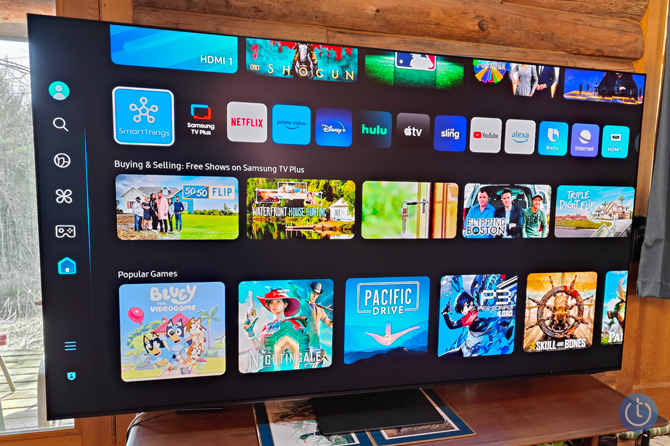
For personal or private listening, you can connect a pair of Bluetooth earbuds or stream via Apple AirPlay. Those addicted to barking orders at smart devices around the house will be pleased to discover that you can configure the set to react to Amazon Alexa voice searches or use Samsung's own voice assistant, Bixby. You can also set the voice assistants to work when the TV is off. Just say, "Hi Bixby," to wake it up and ask for the weather forecast.
Read more: How to Connect a Bluetooth Speaker or Headphones to Your TV
With a Samsung account, which is free, owners can also open Ambient Mode. So rather than seeing floating dots as a screen saver, you can choose from a score of different options, such as a forest glade with background music reminiscent of Satie to animated graphics of skipping stones with rain susurrating in the background. Samsung also offers a raft of its own free content. If you want to do some lateral ski hops, for example, there are free exercise videos that go with your Samsung account. Other features include allowing you to control compatible smart home devices like Philips Hue from the TV. Lastly, the Samsung Gaming Hub site is part of the smart TV experience. Pair up a Bluetooth controller of your choice, and you can start playing free games online.
In the "if it ain't broke, don't fix it" category, Samsung includes the same rechargeable remote from last year's top-of-the-line set with the OLED S95D. The small remote – just under 1.5 inches wide and only 5.5 inches long – is rechargeable thanks to a tiny solar panel on its backside. So you never have to plug it in or change the batteries. And you don't need to leave it tanning in a window. Indoor lighting is sufficient to keep it powered up.
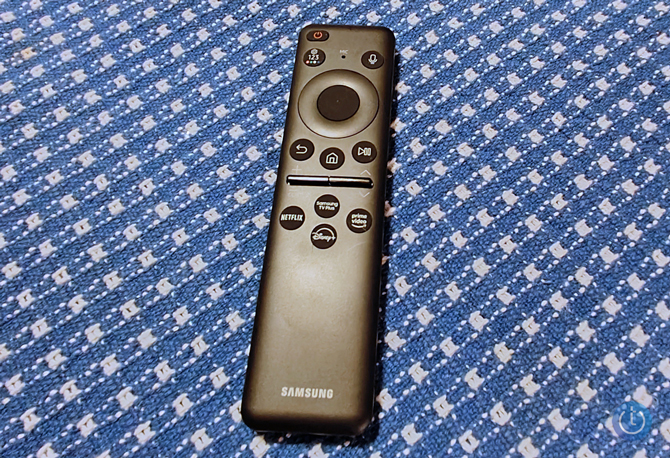
The bottom line
The 77-inch Samsung OLED S95D ($4,599.99) is quite simply a no-compromises premium TV. As such, it compares well to the other contenders in the OLED category, including LG's 77-Inch evo G4 Series TV ($4,599.99) and Sony's Bravia XR 77-inch A95L QD-OLED ($4,999.99). All three top-of-the-line sets deliver the deep blacks and intense highlights OLEDs are famous for. All three sets also appeal to movie lovers, first and foremost. Still, the Samsung OLED S95D has an edge over the other two thanks to its anti-glare glass. I found it extremely helpful in typical viewing situations where lamps and other light sources were on while watching TV.
If you can't accommodate a 77-inch TV or want similar features in a less expensive set, Samsung's next model down is the 65-inch QN65S95DA for $3,399. That's a $1,200 savings for an equally impressive picture.
[Image credit: John R. Quain/Techlicious]
John R. Quain has been covering science and technology for over 20 years. His work has appeared in Rolling Stone, PC Magazine, Esquire, and U.S. News & World Report. He was the on-air technology contributor to the CBS News Up to the Minute television show for 17 years and is a regular contributor to The New York Times.



